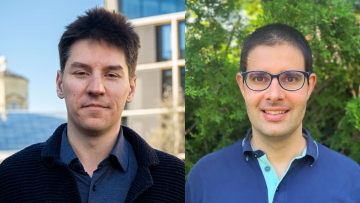10:00
Twisting Higgs modules and applications to the p-adic Simpson correspondence I (special time!)
Abstract
In 2005, Faltings initiated a p-adic analogue of the complex Simpson correspondence, a theory that has since been explored by various authors through different approaches. In this two-lecture series (part I in the Algebra Seminar and part II in the Arithmetic Geometry Seminar), I will present a joint work in progress with Michel Gros and Takeshi Tsuji, motivated by the goal of comparing the parallel approaches we have developed and establishing a robust framework to achieve broader functoriality results for the p-adic Simpson correspondence.
The approach I developed with M. Gros relies on the choice of a first-order deformation and involves a torsor of deformations along with its associated Higgs-Tate algebra, ultimately leading to Higgs bundles. In contrast, T. Tsuji's approach is intrinsic, relying on Higgs envelopes and producing Higgs crystals. The evaluations of a Higgs crystal on different deformations differ by a twist involving a line bundle on the spectral variety. A similar and essentially equivalent twisting phenomenon occurs in the first approach when considering the functoriality of the p-adic Simpson correspondence by pullback by a morphism that may not lift to the chosen deformations.
We introduce a novel approach to twisting Higgs modules using Higgs-Tate algebras, similar to the first approach of the p-adic Simpson correspondence. In fact, the latter can itself be reformulated as a twist. Our theory provides new twisted higher direct images of Higgs modules, that we apply to study the functoriality of the p-adic Simpson correspondence by higher direct images with respect to a proper morphism that may not lift to the chosen deformations. Along the way, we clarify the relation between our twisting and another twisting construction using line bundles on the spectral variety that appeared recently in other works.
14:00
Prosoluble subgroups of the profinite completion of 3-manifold groups
Abstract
In recent years there has been a great deal of interest in detecting properties of the fundamental group $\pi_1M$ of a $3$-manifold via its finite quotients, or more conceptually by its profinite completion.
This motivates the study of the profinite completion $\widehat {\pi_1M}$ of the fundamental group of a $3$-manifold. I shall discuss a description of the finitely generated prosoluble subgroups of the profinite completions of all 3-manifold groups and of related groups of geometric nature.
14:00
Minimal degenerations for quiver varieties
Abstract
For any symplectic singularity, one can consider the minimal degenerations between symplectic leaves - these are the relative singularities of a pair of adjacent leaves in the closure relation. I will describe a complete classification of these minimal degenerations for Nakajima quiver varieties. It provides an effective algorithm for computing the associated Hesse diagrams. In the physics literature, it is known that this Hasse diagram can be computed using quiver subtraction. Our results appear to recover this process. I will explain applications of our results to the question of normality of leaf closures in quiver varieties. The talk is based on joint work in progress with Travis Schedler.
14:00
Gecia Bravo-Hermsdorff: What is the variance (and skew, kurtosis, etc) of a network? Graph cumulants for network analysis
Abstract
Topically, my goal is to provide a fun and instructive introduction to graph cumulants: a hierarchical set of subgraph statistics that extend the classical cumulants (mean, (co)variance, skew, kurtosis, etc) to relational data.
Intuitively, graph cumulants quantify the propensity (if positive) or aversion (if negative) for the appearance of any particular subgraph in a larger network.
Concretely, they are derived from the “bare” subgraph densities via a Möbius inversion over the poset of edge partitions.
Practically, they offer a systematic way to measure similarity between graph distributions, with a notable increase in statistical power compared to subgraph densities.
Algebraically, they share the defining properties of cumulants, providing clever shortcuts for certain computations.
Generally, their definition extends naturally to networks with additional features, such as edge weights, directed edges, and node attributes.
Finally, I will discuss how this entire procedure of “cumulantification” suggests a promising framework for a motif-centric statistical analysis of general structured data, including temporal and higher-order networks, leaving ample room for exploration.


